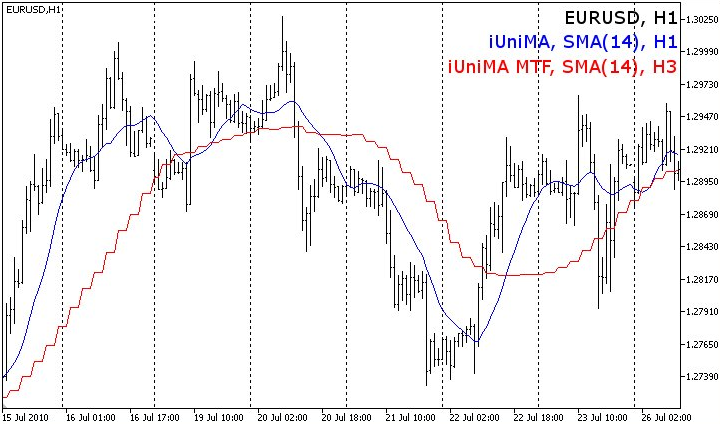Fan sayfamıza katılın
Öyleyse bir link gönderin -
başkalarının da faydalanmasını sağlayın
- Görüntülemeler:
- 150
- Derecelendirme:
- Yayınlandı:
-
Bu koda dayalı bir robota veya göstergeye mi ihtiyacınız var? Freelance üzerinden sipariş edin Freelance'e git
Gerçek yazar:
traderak20, Integer tarafından iUniMA.mq5 temel alınarak oluşturulmuştur
iUniMA MTF göstergesi, kullanıcının farklı hareketli ortalama türleri(SMA, EMA, SMMA, LWMA, AMA, DEMA, TEMA, FRAMA ve VIDYA) arasında seçim yapmasına olanak tanır. Mevcut grafiğin zaman diliminden daha yüksek veya daha düşük herhangi bir zaman dilimine uygulanabilir.
Orijinal iUniMA göstergesi ile karşılaştırıldığında, tek ekstra ayar hesaplamalar için girdi olarak kullanılan ikinci zaman dilimidir. Gösterge, mevcut grafiğin zaman çerçevesinden daha düşük bir zaman çerçevesine uygulandığında, tüm değerleri görüntülemek mümkün değildir. Bu durumda, seçilen fiyat türüne bağlı olarak, en uygun değeri vermek için farklı bir yaklaşım kullanacaktır.
İki örnek:
- timeframe_1=5 dakika, timeframe_2=1 dakika, Kapanış fiyat serisine dayalı hesaplamalar:
Zaman çerçevesi_1'deki herhangi bir çubuk için gösterge, zaman çerçevesi_1'deki çubuğun Kapanış saatinden önce veya Kapanış saatinde olan zaman çerçevesi_2'nin en son çubuğunu gösterecektir. Bu, kapatılmış çubukların yanı sıra hala açık olan mevcut çubuk için de geçerlidir.
- timeframe_1=5 dakika, timeframe_2=1 dakika, hesaplamalar Açık fiyat serisine dayanır:
Zaman çerçevesi_1'deki herhangi bir çubuk için gösterge, zaman çerçevesi_1'deki çubuğun Açılış saatinden önce veya Açılış saatinde bir açılış saati ile zaman çerçevesi_2'nin en son çubuğunu gösterecektir. Bu, kapatılmış çubukların yanı sıra hala açık olan mevcut çubuk için de geçerlidir. Buradaki mantık, göstergelerinizi bir çubuğun Açılış saatinde hesaplamayı seçerseniz, muhtemelen yeni bir çubuk açıldığında da işlem yapacaksınız. Bu durumda, yeni bir 5 dakikalık çubuğun Açılışında, yalnızca onun bir parçası olan beş 1 dakikalık çubuğun ilkinin Açılışını bileceksiniz. Bu nedenle, ikinci ila beşinci 1 dakikalık çubukların Açılışı hesaplamalarda göz ardı edilir.
Senkronize olmasalar bile herhangi bir zaman çerçevesini başka bir zaman çerçevesiyle karıştırabilirsiniz, örneğin timeframe_1 = 5 dakika ve timeframe_2 = 12 dakika. Gösterge senkronize kalmalarını sağlayacaktır. Bunun çalışma şekli yukarıdaki örneklere benzer.
Bir excel sayfasında daha görsel bir açıklama için MACD Histogram MTF MC göstergesine bakın.
Zaman dilimleri arasında geçiş yaparken, fiyat verilerinin yüklenmesi için biraz zaman (birkaç saniye) bekleyin. Gösterge görüntülenmiyorsa, grafiği manuel olarak yenileyin.
Hata mesajlarını açmak/kapatmak için kaynağa bakın:
bool ShowErrorMessages=false; // hata ayıklama için hata mesajlarını aç/kapat

Güncelleme geçmişi:
2010 09 26: v03
- Grafiğin zaman diliminden daha küçük zaman dilimlerindeki değerlerin görüntülenmesi iyileştirildi;
- Tamponları 0 yerine EMPTY_VALUE olarak ayarlayın: if(convertedTime<tempTimeArray_TF2[0]);
- Kod optimizasyonu;
- PLOT_DRAW_BEGIN OnInit()'ten kaldırıldı - tek zaman dilimi göstergesinden miras alındı;
- Tamponların ve dizilerin ArraySetAsSeries'i OnInit() içine taşındı;
2010 08 28: v02
- Gösterge ilk yayınlandı;
MetaQuotes Ltd tarafından İngilizceden çevrilmiştir.
Orijinal kod: https://www.mql5.com/en/code/180
 Self Optimized SMA
Self Optimized SMA
Gösterge iki çizgi çizer. Alt çizgi, yukarı sıçramaya neden olan en son SMA dönemine göre hesaplanır. Üst çizgi, aşağı sıçramaya neden olan en son SMA dönemine göre hesaplanır.
 Useful #define statements
Useful #define statements
Bunlar, EA'nızdaki işlemleri gerçekleştirmek için yararlı olan bazı #define deyimleridir. Sadece değişkenlerinizin adını dosyanın başına atamanız ve ardından diğer #define deyimlerinin işi yapmasına izin vermeniz gerekir. Bu dosyayı kullanmak için, EA dosyanızdaki ilk satıra #include <DEFINE_statements.mqh> ekleyin.
 Fiyat Kanalı
Fiyat Kanalı
Kullanıcı tabanında zaten bir Fiyat Kanalı göstergesi var, ancak kişisel olarak bundan hoşlanmıyorum ve uymuyor çünkü yukarı ve aşağı arasındaki tüm boşluğu renklendiriyor. Önerilen varyantta Fiyat Kanalı MetaTrader 4'teki gibi görünecektir.
 ProMart
ProMart
Geliştirilmiş MartGreg.